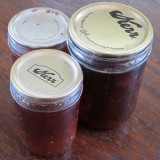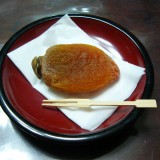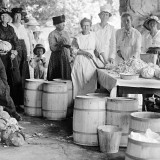
Around once a month I teach a bread class at the one of a kind Institute of Domestic Technology, founded by our friend Joseph Shuldiner. The IDT is not your usual cooking school and its offerings are difficult to define succinctly. If I had to take a stab at explaining what the IDT does it would be that it teaches things worth doing from scratch that most people haven’t attempted since the pre-Betty Crocker era: cheesemaking, home coffee roasting, bacon curing, bread baking, jam and exotic projects like making your own nocino and toothpaste.
One of the perks of teaching at the IDT is getting to sit in on some of the other classes. The coffee roasting class changed my life. Now, every morning, I look forward to fresh coffee I roasted myself in a Whirley-Pop Popcorn maker. This past weekend I sat in a new IDT class taught by author Andrea Nguyen on how to make tofu from scratch.

Nguyen is the author of a couple of cookbooks including Asian Tofu: Discover the Best, Make Your Own, and Cook It at Home and a new book, The Banh Mi Handbook: Recipes for Crazy-Delicious Vietnamese Sandwiches. She began the tofu class with with some soy beans that were soaked the night before. The pre-soaked beans were ground up in a blender and the slurry was boiled in a pot with some water.

The mixture was poured through a cloth to produce soy milk. The cloth was gathered up and squeezed to get out every drop of milk.

Nguyen showed us three different ways to create blocks of tofu with everything from a simple colander to a plastic tofu kit, to a beautiful Japanese wooden tofu form.

The next step was to coagulate the soy milk using nigari crystals (available at Asian markets).

After the soy milk separated the curds were ladled into the forms.

In just a short time we had blocks of delicious tofu.

One of the students brought some dehydrated crackers to class. He makes them with discarded fruit pulp that he gets at a local juice bar. He dehydrates the pulp with some soaked sunflower seeds. The result is delicious. It’s a clever idea.
Back to the tofu. I’m going to try making my own this summer. At the very least I can make my own soy milk and skip the sugary stuff I’ve been using.
You can get organic non-GMO soybeans and coagulant online at www.laurasoybeans.com.
Incidentally, IDT founder Joseph Shuldiner wrote my favorite vegan cookbook which is aimed at vegans and non-vegans (such as myself) alike: Pure Vegan: 70 Recipes for Beautiful Meals and Clean Living.






I took the nocino class a few years ago. I have to agree with you that it’s a wonderful learning experience. …and I say that as someone who has a walnut tree and who had been making nocino for a number of years before I learned of the IDT and registered for the class.
I always look for a new class that fits my curiosities and the holes in my culinary skill set.
It’s sorta tragic that the classes are so expensive. I bet there are far more people who could benefit from them than are able to afford them.
Back in the day when tofu wasn’t mainstream and somewhat hard to find, I caved and bought a small wooden press to make my own tofu.
This was 1978. My mother, worried about my vegetarian diet,thought I’d really gone off the deep end. I remember feeding my cats some of the ‘waste’. Don’t think I’d do that now, but I felt all noble and self-sufficient at the time. The book, Diet for a Small Planet, really influenced a lot of people to question meat production/consumption.
The crackers are what interest me. Did you get any further information about making those?
It was pretty simple. He got the pulp from a juice place, added some pre-soaked sunflower seeds and a little bit of guava juice then stuck it into a food dehydrator. Let me know if that answers your question. They were very tasty.
Thanks. Is there a specific reason for the sunflower seeds other than personal preference or nutrition? Do the sunflower seeds have mucilaginous properties or other properties that would be necessary? I am thinking that I would prefer pecans. Of course, there are walnuts in the freezer. I think I have some canned guava juice, but I wonder if the juice from other fruits might work. I do have the dehydrator.
I have heard that people with juicers have used the pulp in muffins rather than put it on the compost pile or feed the chickens. My chickens would get a portion or maybe a muffin.
I think he was kind of following the standard raw cracker recipe which usually involves sunflower seeds. I don’t think they have mucilaginous properties, but they give the cracker a nice texture. Other fruit juices would work–the pulp is a bit dry and needs something to hold it together.
I have a neighbor who gathers the pulp from a local juice place and composts it. What’s funny is that people are paying for something that’s not really good for them (fruit juice) while the pulp is the good part that’s given away for free.